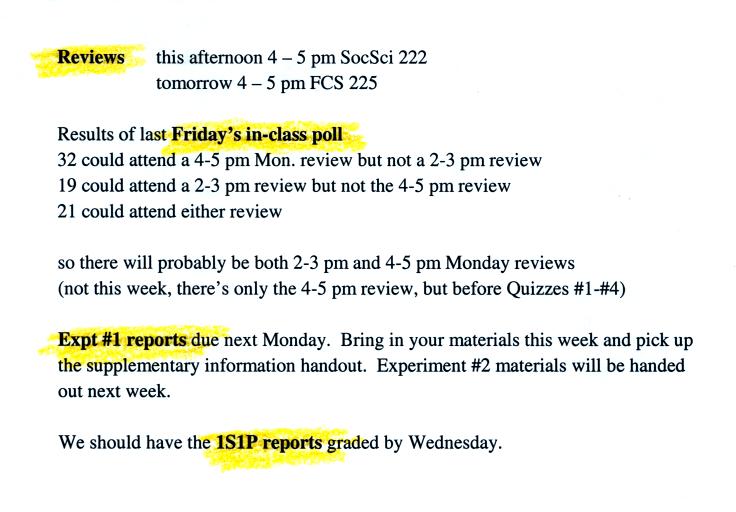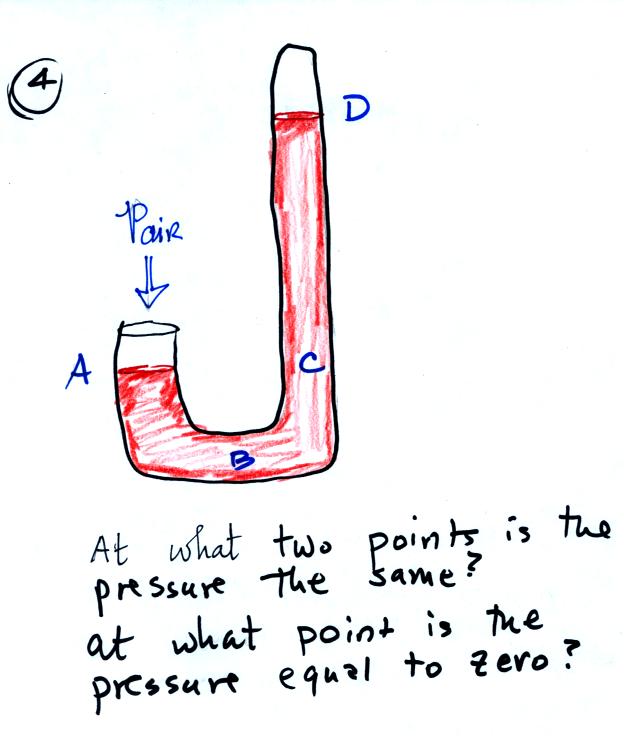Monday Jan. 31, 2011
click here to download today's notes in a more
printer friendly format
Three songs from Brandi Carlile
this morning before class ("My Song", "I Will", and "The Story").
The Practice Quiz is Wednesday this week. You'll have about
half the period to work on the quiz.
Here are the first two questions on an In-class Optional
Assignment (you answer the questions on a blank sheet of paper, turn
them in at the end of class, and if you make an honest attempt to
answer all the questions you'll earn a little extra credit). If
you weren't in class but are reading through today's class notes and
want to turn in the assignment at the beginning of class on Wednesday
you can earn at least partial credit. There are a total of 5
questions on the assignment.
The next
bunch of material tries to explain how a mercury barometer
works. A mercury
barometer is used to measure atmospheric pressure and is really
just a balance that can be used to weigh the
atmosphere. You'll find a somewhat messier version of of what
follows on p. 29 in the
photocopied Class Notes.
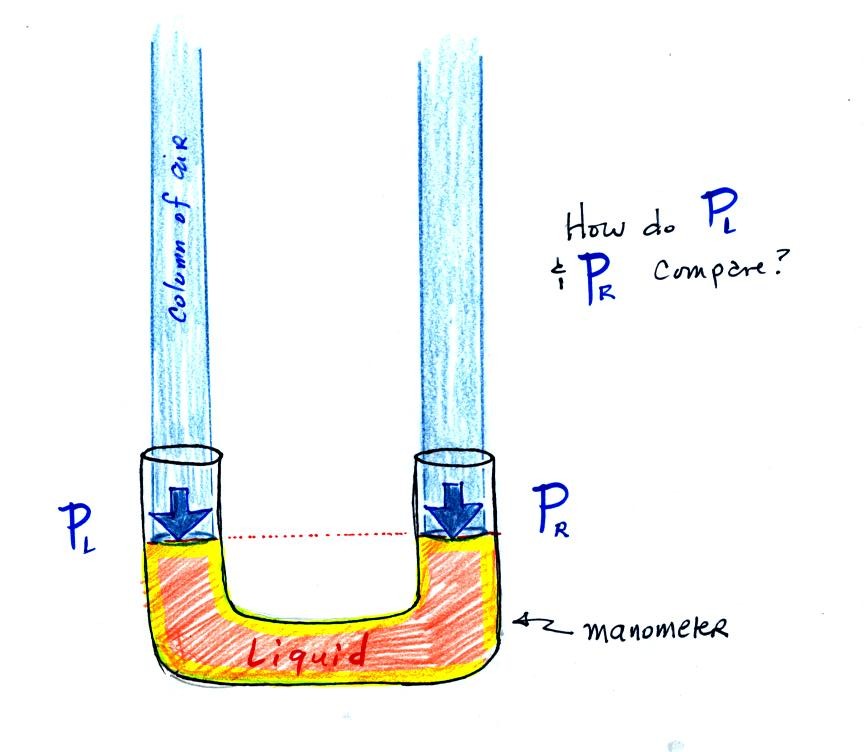 |
 |
The instrument in the left figure
above ( a u-shaped
glass
tube filled with a
liquid of some kind) is actually called a manometer and can be used to
measure pressure
difference. The
two ends of the tube are open so that air can get inside and air
pressure can press on the liquid. Given that the liquid levels on
the two sides of the manometer
are equal, what could you about PL and PR?
The liquid can slosh back and
forth just like the pans on a balance can move up and down. A
manometer really behaves just like a pan balance (pictured at
right) or a teeter totter (seesaw).
Because
the
two
pans
are
in
balance,
the
two columns of
air have the same weight. PL and PR
are equal (but note
that you don't really know what either pressure is, just that they are
equal).
 |
 |
Now
the
situation is a little
different,
the
liquid levels
are no
longer equal. You probably realize that the air pressure on the
left, PL, is a little higher than the air pressure on the
right,
PR. PL is now being balanced by PR
+ P acting together. P
is the pressure produced by the weight of the extra fluid on the right
hand side of
the manometer (the fluid that lies above the dotted line). The
height
of
the
column
of
extra
liquid
provides
a
measure
of
the
difference
between
PL and PR.
Next we will just go and close off
the right hand side of the
manometer.
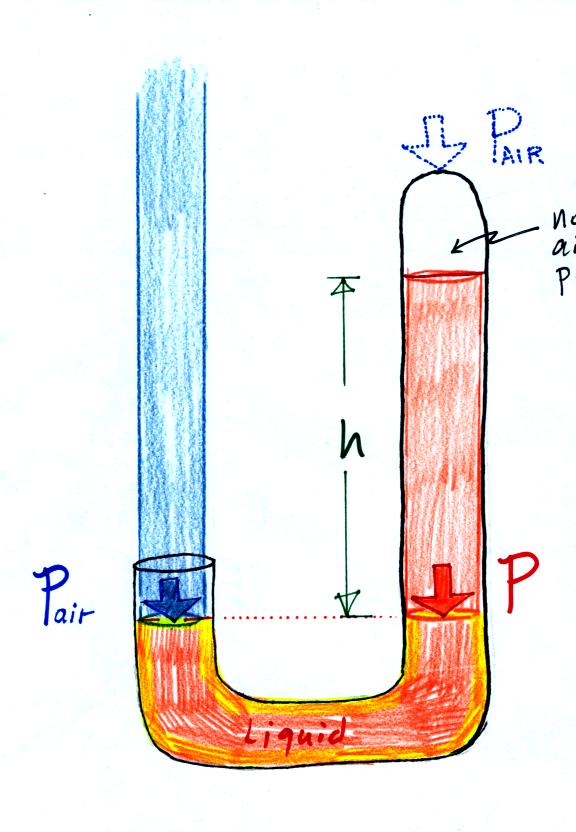
|

|
Air pressure can't get into the
right tube any
more. Now at the level of the dotted line the balance is between
Pair and P (pressure by the extra liquid on the
right). If
Pair
changes, the height of the right column, h, will
change. You now have a barometer, an instrument that can measure
and monitor the atmospheric pressure. (some of the writing
in the upper right portion of the left figure was cut off, it should
read "no air
pressure")
Barometers like this are usually
filled with mercury. Mercury is
a liquid. You need a liquid that can slosh back and forth in
response to changes in air pressure. Mercury is also very dense
which
means the barometer won't need to be as tall as if you used something
like water. A water barometer would need to be over 30 feet
tall. With mercury you will need only a 30 inch tall column to
balance the weight of the atmosphere at sea level under normal
conditions (remember the 30 inches of mercury pressure units mentioned
earlier). Mercury also has a low rate of
evaporation so you don't have much mercury gas at the top of the right
tube (it is the mercury vapor that would make a mercury spill in the
classroom dangerous).

Here is a more conventional
barometer design.
The bowl of
mercury is usually covered in such a way that it can sense changes in
pressure but is sealed to keep poisonous mercury
vapor from filling a room.
In an earlier class we saw that a
52 inch long 1"x1" steel bar
weighs the same as a 1" x 1" column of air stretching from sea level to
the top of the atmosphere. Now we can add a 30 inch tall 1" x 1"
column of mercury (frozen so that it would be rigid) to the list.
All three columns above would weigh 14.7 pounds. They would all
be pushing against the ground with a pressure of 14.7 psi.
Here's
Optional Assignment question #3

The figure above (p. 30 in the
photocopied Class Notes)
first
shows average sea level pressure values. 1000 mb or 30 inches of
mercury are close enough in this class.
Sea level pressures
usually fall between 950 mb and 1050 mb.
Record high sea level
pressure values occur during cold weather. The TV weather
forecast will often associated hot weather with high pressure.
They are generally referring to upper level high pressure (high
pressure at some level above the ground) rather than surface pressure.
Record low pressure
values have all been set by intense hurricanes (the record setting low
pressure is the reason these storms were so intense). Hurricane
Wilma in 2005 set a new record low sea level pressure reading for the
Atlantic. Hurricane Katrina had a pressure of 902 mb.
The following table lists some of the information on hurricane strength
from p. 146a in the photocopied ClassNotes. 3 of the 10 strongest
N. Atlantic hurricanes occurred in 2005.
Most
Intense
North
Atlantic
Hurricanes
|
Most
Intense
Hurricanes
to
hit
the
US
Mainland
|
Wilma
(2005)
882
mb
Gilbert (1988) 888 mb
1935 Labor Day 892 mb
Rita (2005) 895 mb
Allen (1980) 899
Katrina (2005) 902
|
1935
Labor
Day
892
mb
Camille (1969) 909 mb
Katrina (2005) 920 mb
Andrew (1992) 922 mb
1886 Indianola (Tx) 925 mb |
Here are
the last two Optional Assignment questions
Question #4
and Question #5

I'm sticking p. 33 from the
ClassNotes back in at this point even though we covered this material
last Friday.

Pressure pushes upward, downward,
and sideways.
This was a logical point to do a
demonstration. A demo that
tries to prove that air pressure really does push upward as well as
downward. Not only that but that the upward force is fairly
strong. The demonstration is summarized on p. 35 a in the
ClassNotes.
Here's a little bit more detailed
and more complete explanation of
what is going on. First the case of a water balloon.
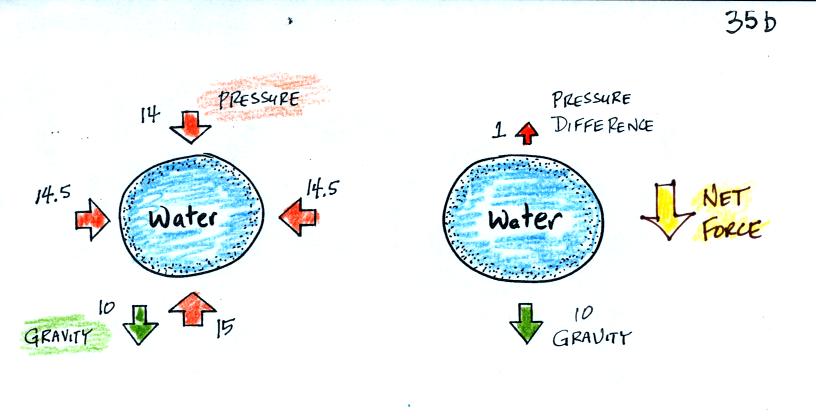
The figure at left shows air
pressure (red
arrows)
pushing on all
the
sides of the balloon. Because pressure decreases with increasing
altitude, the pressure from the air at the top of the balloon pushing
downward (strength=14) is a
little weaker than the pressure from the air at the bottom of the
balloon that is pushing upward (strength=15). The two sideways
forces cancel each other
out. The
total effect of the pressure is a weak upward force (1 unit of upward
force shown at the top of the right
figure, you might have heard this called a bouyant force).
Gravity exerts a downward force on the water
balloon. In the figure at right you can see that the gravity
force (strength=10) is stronger than the upward pressure difference
force (strength=1). The
balloon falls as a result. This is what you know would happen if
you let go of a water balloon, it would fall.
In the demonstration a wine glass is filled with water. A
small
plastic lid is used to cover the wine glass. You can then turn
the glass upside down without the water falling out.

All the same forces are shown again
in the left most
figure.
In
the right two figures we separate this into two parts. First
the water inside the glass isn't feeling the downward and sideways
pressure forces (because they're pushing on the glass, this is shown at
the right side of the figure above). Gravity
still pulls downward on the water but the upward pressure force is able
to overcome the downward pull of gravity. The upward pointing
pressure force is used to overcome gravity not to cancel out the
downward pointing pressure force.
The demonstration was repeated using a 4 Liter flash (more than a
gallon of water, more than 8 pounds of water). The upward
pressure force was still able to keep the water in the flask (much of
the weight of the water is pushing against the sides of the flask which
the instructor was supporting with his arms).
We spent the last portion of the period looking at how
temperature
changes with increasing altitude in the atmosphere. Temperature
can increase, decrease, even remain constant with increasing
altitude. The figures below are more clearly drawn versions of
what was done in class.
The atmosphere can be split
into layers
depending on whether
temperature is increasing or decreasing with increasing altitude.
The two lowest layers are shown in the figure above. There are
additional layers (the mesosphere and the thermosphere) above 50 km but
we won't worry about them.
1. We live in
the troposphere. The troposphere is found, on average, between 0
and about 10 km altitude, and is where temperature usually decreases
with
increasing altitude. [the troposphere is usually a little higher
in the tropics and lower at polar latitudes]
The troposphere contains most of the water vapor
in the atmosphere (the water vapor comes from evaporation of ocean
water and then gets mixed throughout the troposphere by up and down air
motions) and is
where most of the clouds and weather occurs. The
troposphere can be stable or unstable (tropo means to turn over and
refers to the fact that air can move up and down in the
troposphere).
2a. The thunderstorm shown in
the figure with its strong updrafts and downdrafts indicates unstable
conditions. When the thunderstorm reaches the
top of the troposphere, it runs into the bottom edge of the
stratosphere which is a very stable layer. The
air can't continue to rise into the stratosphere so the cloud
flattens out and forms an anvil (anvil is the name given to the flat
top of the thunderstorm). The
flat anvil top is something
that you can go outside and see and often marks the top of the
troposphere.
2b. The summit of Mt. Everest is a little over 29,000
ft. tall and is
close to the average height of the top of the troposphere.
2c. Cruising altitude in a passenger jet is usually between
30,000 and 40,000, near or just above the top of the troposphere, and
at the bottom of the stratosphere.
3. Temperature remains constant between 10 and 20 km
and then
increases with increasing altitude between 20 and 50 km. These
two sections form the stratosphere. The stratosphere is a
very stable air layer. Increasing temperature with increasing
altitude is called an
inversion. This is what makes the stratosphere so stable.
4. A kilometer is one
thousand meters. Since 1 meter is about 3 feet, 10 km is about
30,000 feet. There are 5280 feet in a mile so this is about 6
miles (about
is usually close enough in this class).
5. Sunlight is a mixture of ultraviolet (7%),
visible (44%), and
infrared light (49%). We can see the visible light.
5a. On average about 50% of the sunlight
arriving at the top of
the atmosphere passes through the atmosphere and is absorbed at the
ground (20% is absorbed by gases in the air, 30% is reflected back into
space). This warms the ground. The air in contact with the
ground is warmer than air just above. As you get further and
further from the warm ground,
the
air
is
colder
and
colder.
This
explains
why
air
temperature
decreases with increasing altitude in the
troposphere.
5b. How do you explain increasing temperature with
increasing
altitude in the stratosphere.
The ozone layer is found in the stratosphere
(peak concentrations are found near 25 km altitude). Absorption
of
ultraviolet light by ozone warms the air in the stratosphere and
explains why the air can warm. The air in the stratosphere is
much less dense (thinner) than in the troposphere. So even though
there is not very much UV light in sunlight, it doesn't
take as much energy to warm this thin air as it would to warm denser
air closer to the ground.
6. I didn't mention
this point in class. That's a manned
balloon;
Auguste Piccard and Paul Kipfer are
inside. They were the first men to travel into the
stratosphere (see pps 31 & 32 in
the photocopied Class Notes) We might have a look at a short
segment
of video at some point that describes their voyage. It really was
quite a daring trip at the time at the
time,
and they very
nearly didn't survive it.
I'll put answers to the In Class Optional Assignment online
sometime Tuesday.
